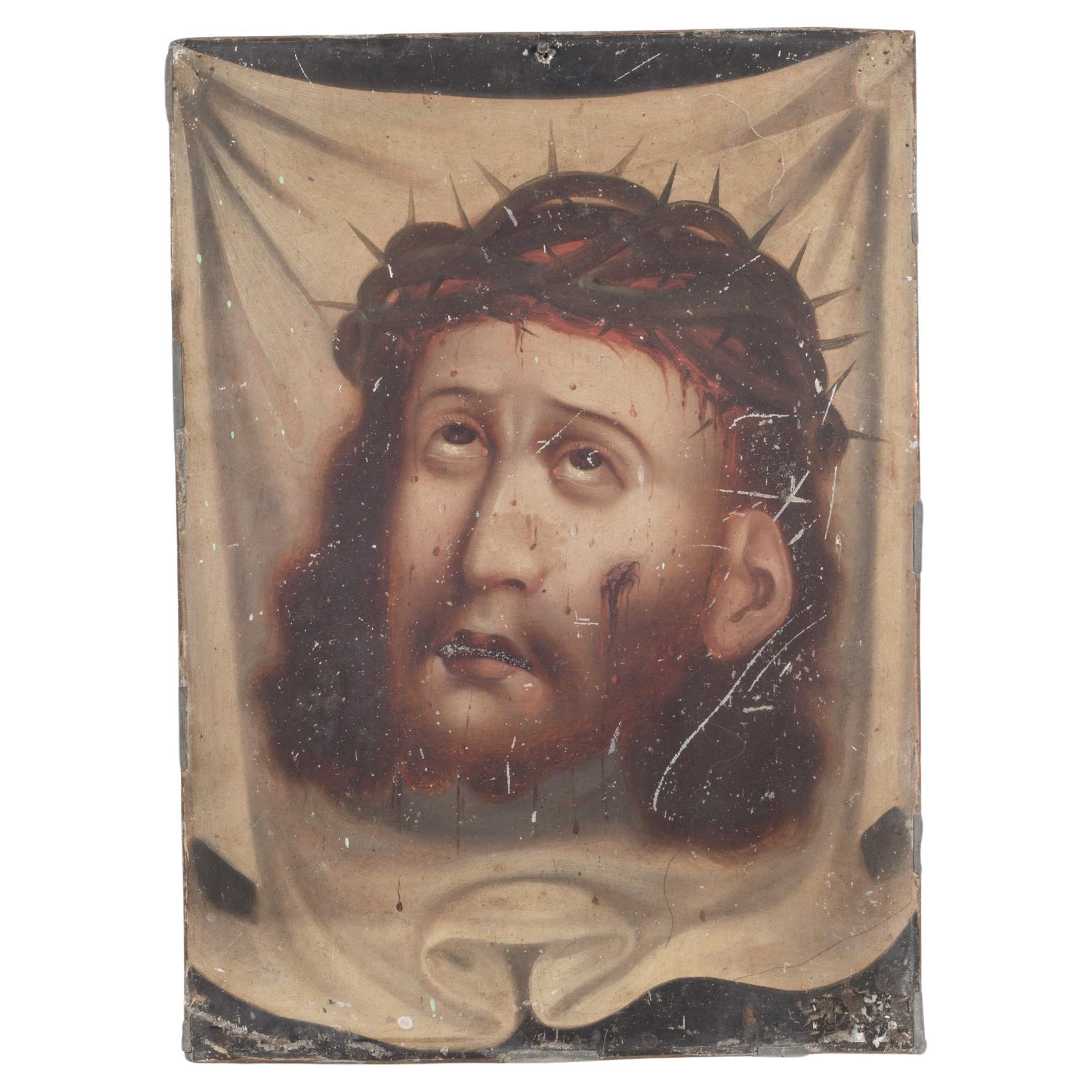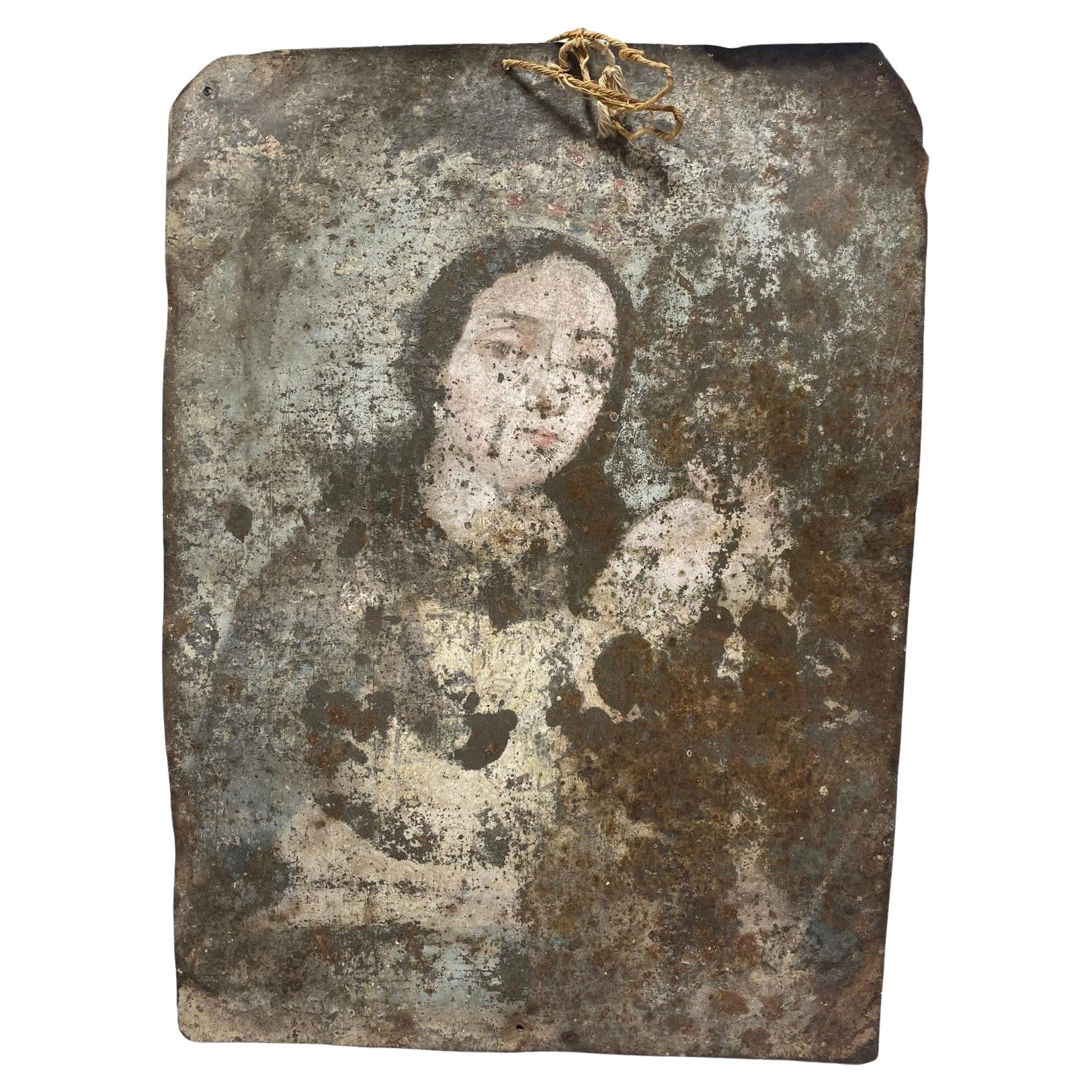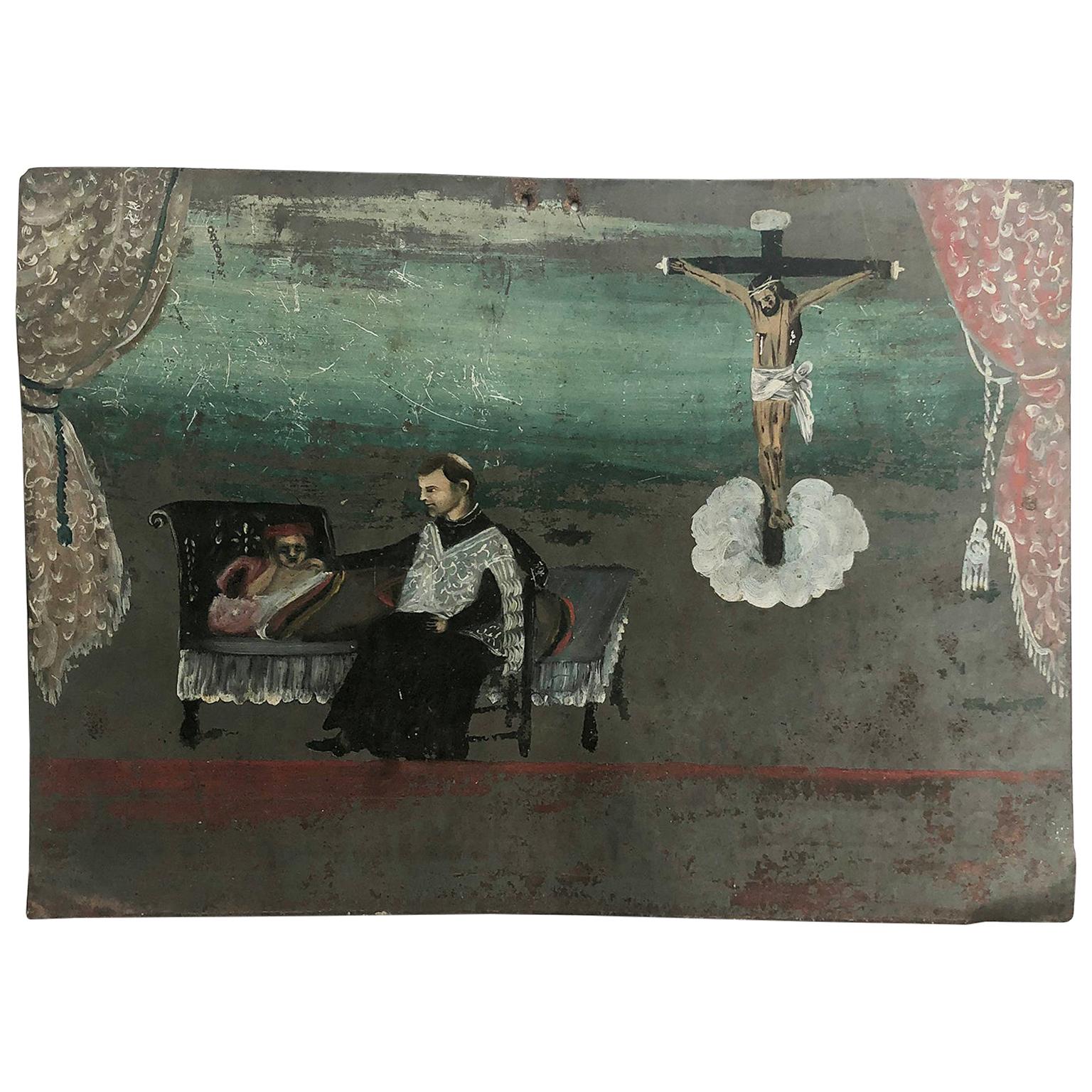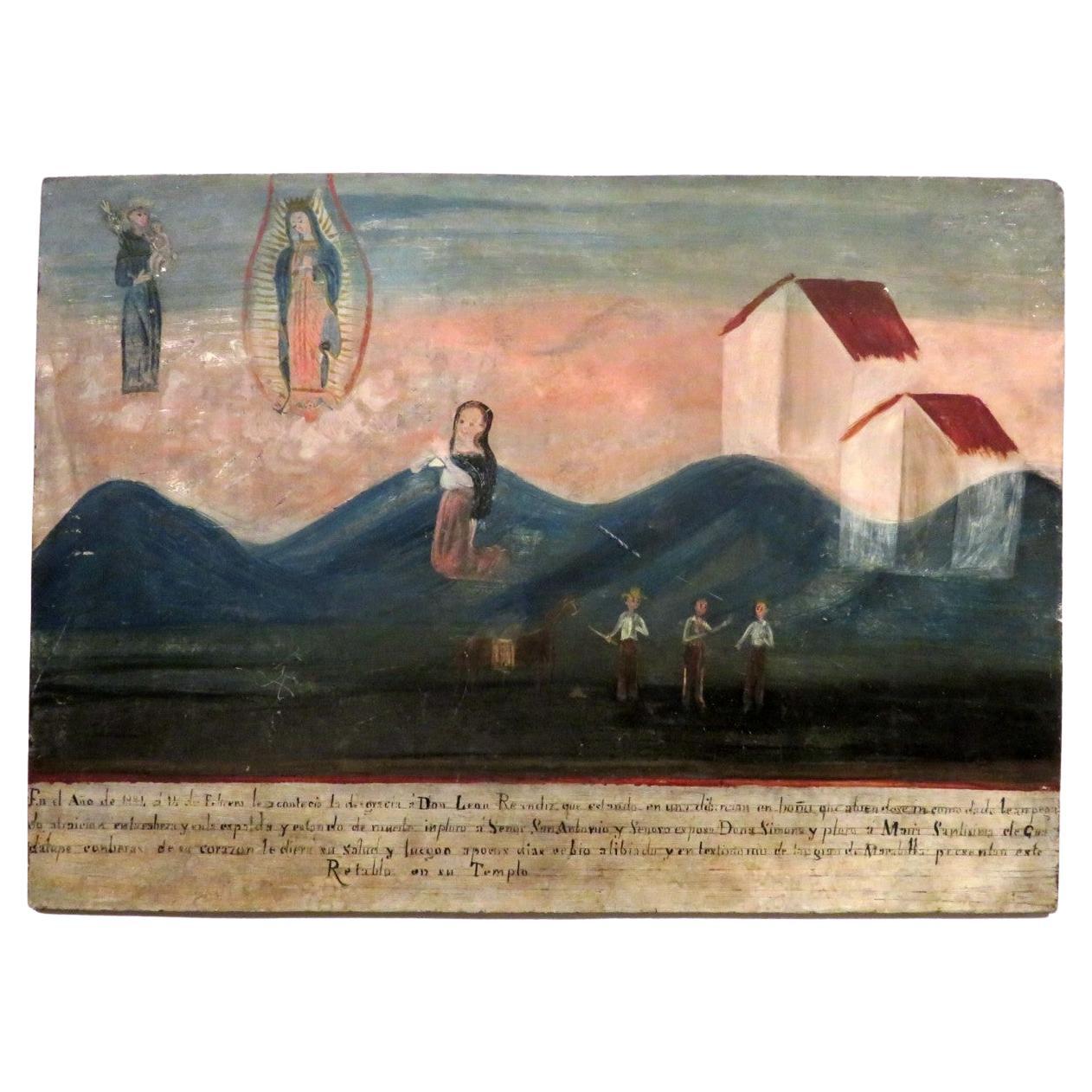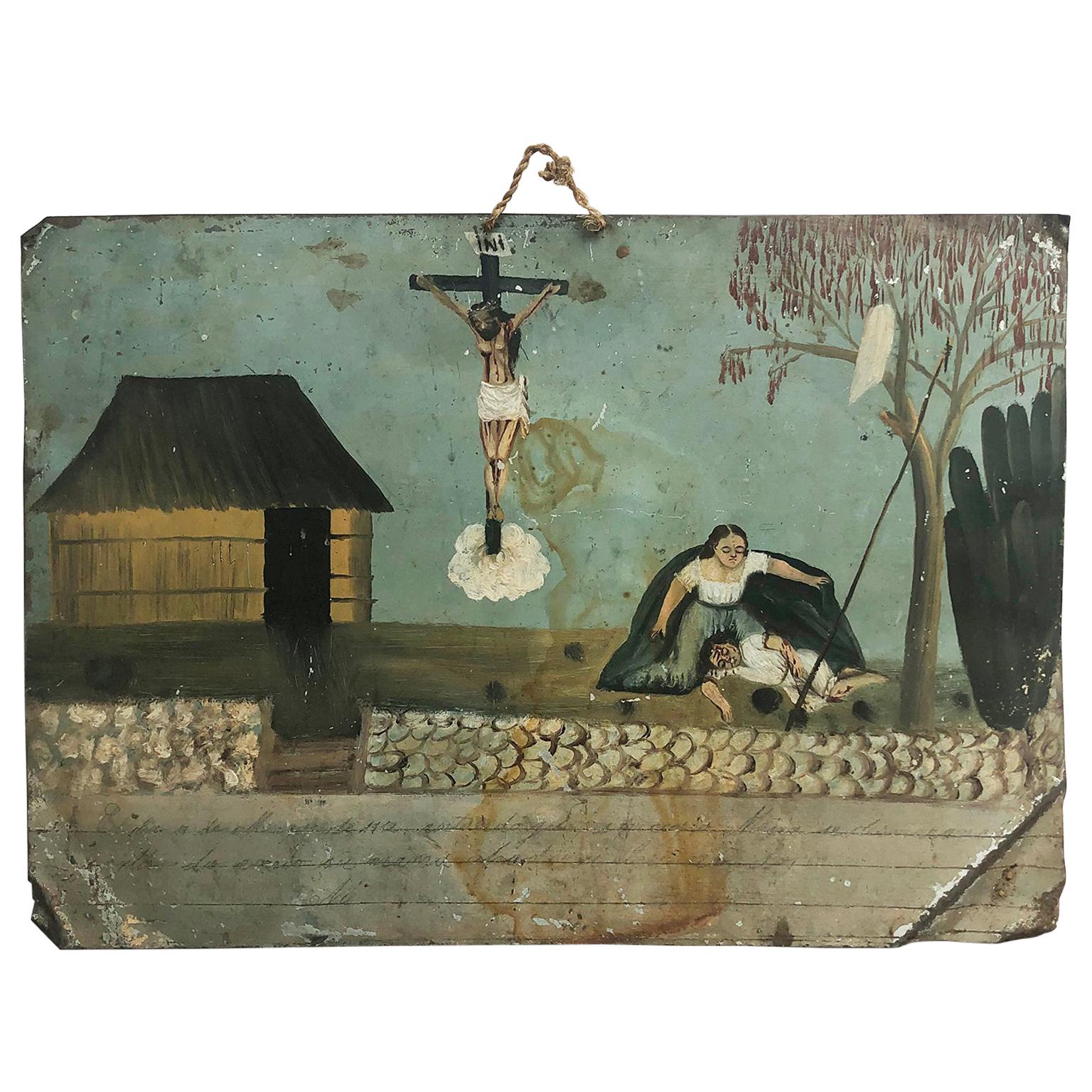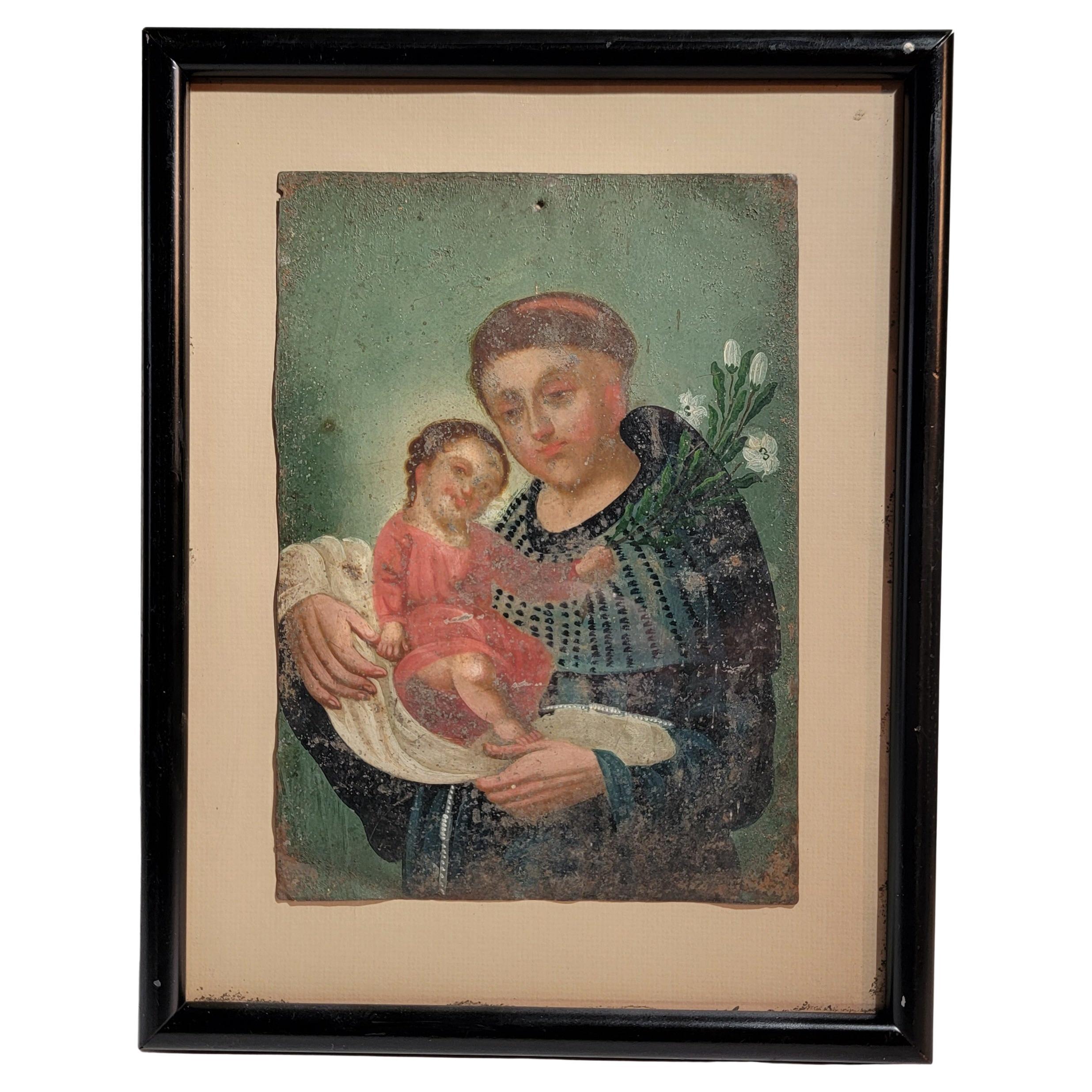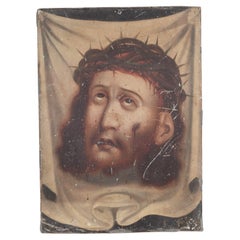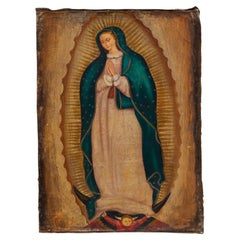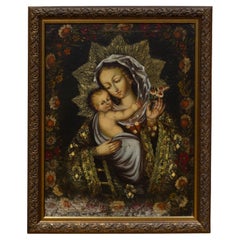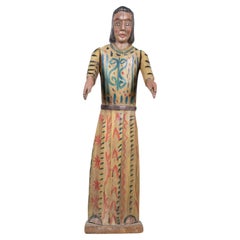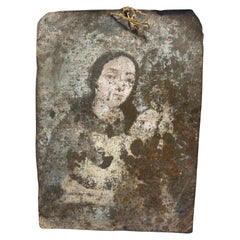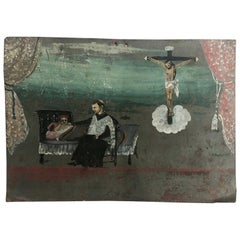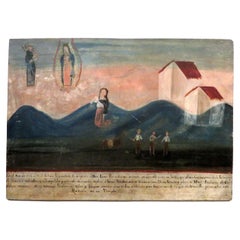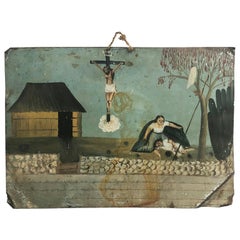Objekte ähnlich wie 19. Jahrhundert Mexikanisches Retablo „Veronica's Veil“ um 1880
Möchten Sie mehr Bilder oder Videos?
Zusätzliche Bilder oder Videos von dem*der Anbieter*in anfordern
1 von 5
19. Jahrhundert Mexikanisches Retablo „Veronica's Veil“ um 1880
1.007,34 €
Angaben zum Objekt
ABOUT
An original 19th century Mexican folk retablo "Veronica's Veil" or "El Divono Rostro" in Spain . Oil paint on tin.
The Veil of Veronica, known in Italian as the Volto Santo or Holy Face, is a Roman Catholic Relic which, according to legend, bears the likeness of the Face of Jesus that was imprinted on it prior to Jesus' crucifixion. According to Roman Catholicism, Saint Veronica encountered Jesus in Jeruselum on the way to Calvary. When she paused to wipe the sweat (Latin, suda) off his face with her veil, his image was left on the veil.
In the small village of Osa de la Vega in Spain, there lived a couple who led a very pious life. They were Gregorio de la Torre and Isabel Corral. From their father, Juan Montilla, they inherited a picture of the Face of Jesus or the Divino Rostro. A story that is told one day, to the amazement of many who confirmed its veracity, the picture began to perspire with living blood. News of this extraordinary event spread swiftly and widely throughout the land.
CREATOR Unknown.
DATE OF MANUFACTURE c.1880.
MATERIALS AND TECHNIQUES Oil Paint on Tin.
CONDITION Good. Alters- und gebrauchsbedingte Abnutzungserscheinungen.
DIMENSIONS H 14 in. W 10 in.
HISTORY
Retablos, better known as 'laminas' in Mexico, are small oil paintings on tin, wood and sometimes copper which were used in home altars to venerate the almost infinite number of Catholic saints. The literal translation for 'retablo' is 'behind the altar.' This unique genre of art, deeply rooted in European history, was brought to Mexico with the arrival of the Spanish and then ultimately adopted by New World mestizo natives to become what is known today as the Mexican folk retablo.
The retablo was an art form that flourished in post conquest Mexico and then ultimately, with the introduction of inexpensive mediums such as tin, reached its pinnacle of popularity in the last quarter of the 19th century. With some exceptions, mostly untrained artists from the provinces worked to produce and reproduce these sacred images; some subjects painted more prolifically than others. A typical "retablero" may have reproduced the same image hundreds, if not thousands of times in his or her career.
These oil paintings were sold to devout believers who displayed them in home altars to honor their patron saints. There are virtually hundreds of saints, each invoked to remedy a different situation. "San Ysidro Labrador," the patron saint of farmers, is venerated for good weather, agricultural issues and prosperous crop. He is often called upon before picnics or just before harvest. Having spent four years in the forest as a hermit, San Jeronimo, the patron saint of scholars and philosophers, is invoked for protection against temptations and want.
Bearing some semblance to retablos, 'ex-votos' are devotional paintings on canvas or tin which offer thanks to a particular saint in the form of a short narrative. In many events, a small child becomes ill, a soldier returns safely from war, or a favorite animal is reunited with its owner. The petitioner, grateful for this miracle, dedicated a small painting (with a short testimonial) to the respective patron Saint.
These unique art forms are a hybrid of centuries old Catholic iconography and indigenous artistry; reflecting the historical, cultural and religious links between "old" and "new" worlds.
- Maße:Höhe: 35,56 cm (14 in)Breite: 25,4 cm (10 in)Tiefe: 5,08 mm (0,2 in)
- Stil:Volkskunst (Aus dem Zeitalter)
- Materialien und Methoden:
- Herkunftsort:
- Zeitalter:
- Herstellungsjahr:1880
- Zustand:Abnutzung dem Alter und der Nutzung entsprechend.
- Anbieterstandort:San Francisco, CA
- Referenznummer:1stDibs: LU1280227923232
Anbieterinformationen
5,0
Geprüfte*r Anbieter*in
Jede*r Anbieter*in erfüllt strenge Standards bezüglich Echtheit und Zuverlässigkeit
Gründungsjahr 2014
1stDibs-Anbieter*in seit 2015
1.330 Verkäufe auf 1stDibs
Typische Antwortzeit: 1 Stunde
- VersandAngebot wird abgerufen …Versand von: San Francisco, CA
- Rückgabebedingungen
Einige Inhalte dieser Seite wurden automatisch übersetzt. Daher kann 1stDibs nicht die Richtigkeit der Übersetzungen garantieren. Englisch ist die Standardsprache dieser Website.
Authentizitätsgarantie
Im unwahrscheinlichen Fall eines Problems mit der Echtheit eines Objekts kontaktieren Sie uns bitte innerhalb von 1 Jahr für eine volle Rückerstattung. DetailsGeld-Zurück-Garantie
Wenn Ihr Objekt nicht der Beschreibung entspricht, beim Transport beschädigt wurde oder nicht ankommt, kontaktieren Sie uns bitte innerhalb von 7 Tagen für eine vollständige Rückerstattung. DetailsStornierung innerhalb von 24 Stunden
Sie können Ihren Kauf jederzeit innerhalb von 24 Stunden stornieren, ohne jegliche Gründe dafür angeben zu müssen.Geprüfte Anbieter*innen
Unsere Anbieter*innen unterliegen strengen Dienstleistungs- und Qualitätsstandards, wodurch wir die Seriosität unserer Angebote gewährleisten können.Preisgarantie
Wenn Sie feststellen, dass ein*e Anbieter*in dasselbe Objekt anderswo zu einem niedrigeren Preis anbietet, werden wir den Preis entsprechend anpassen.Zuverlässige weltweite Lieferung
Unsere erstklassigen Versandunternehmen bieten spezielle Versandoptionen weltweit, einschließlich individueller Lieferung.Mehr von diesem*dieser Anbieter*in
Alle anzeigenMexikanisches Retablo „Veronica's Veil“ aus dem 19. Jahrhundert, um 1880
About
An original 19th century Mexican folk retablo "Veronica's Veil" or "El Divono Rostro" in Spain . Oil paint on tin.
The Veil of Veronica, known in Italian as the Volto San...
Kategorie
Antik, 19. Jahrhundert, Mexikanisch, Volkskunst, Gemälde
Materialien
Zinn
Anfang 20. Jh. Virgin of Guadalupe, Bolivien, Öl auf Leinwand Gemälde
ÜBER
Jungfrau von Guadalupe, unsigniert, Öl auf Leinwand, ungerahmt.
CREATOR Ohne Vorzeichen.
HERSTELLUNGSDATUM ca. 1910-1940.
MATERIALIEN UND TECHNIKEN Öl auf Leinwa...
Kategorie
Frühes 20. Jahrhundert, Bolivianisch, Spanisch Kolonial, Gemälde
Materialien
Farbe
Madonna und Kind, Peru, Öl auf Leinwand Gemälde, vor 1970
ÜBER
Peruanische Cuzco-Schule, Madonna mit Kind, ohne Titel. Öl auf Leinwand, vor 1970.
CREATOR Ohne Vorzeichen.
HERSTELLUNGSDATUM ca. vor 1970.
MATERIALIEN UND TECHNIK...
Kategorie
Mitte des 20. Jahrhunderts, Peruanisch, Gemälde
Materialien
Holz, Farbe
1.569 € Angebotspreis
30 % Rabatt
Mitte 20. Jh. Geschnitzter Santo aus Holz, ca. 1950-1960
ÜBER
Ein handbemalter, geschnitzter mexikanischer oder mittelamerikanischer Santo (Heiliger) aus Holz mit beweglichen Armen.
SCHÖPFER Unbekannt.
HERSTELLUNGSDATUM ca. 1950-...
Kategorie
Antik, 19. Jahrhundert, Mexikanisch, Industriell, Figurative Skulpturen
Materialien
Holz, Farbe
152 € Angebotspreis
32 % Rabatt
Frühes 19. Jahrhundert Terrakotta-Büste mit Glasaugen ca. 1800-1840
ÜBER
Eine bemalte Terrakottabüste aus dem frühen 19. Jahrhundert mit Glasaugen auf einem Holzsockel.
SCHÖPFER Unbekannt.
HERSTELLUNGSDATUM ca. 1800-1850.
MATERIALIEN UN...
Kategorie
Antik, Frühes 19. Jahrhundert, amerikanisch, Viktorianisch, Figurative S...
Materialien
Holz, Farbe
1.016 € Angebotspreis
22 % Rabatt
Handgefertigtes mexikanisches Tragetasche aus Leder, ca. 1900-1940
Über
Ein handgefertigtes Ledergehäuse aus Mexiko mit eingraviertem Leder auf beiden Seiten und intaktem Lederarmband. Das Lederband ist sowohl durch den Deckel als auch durch den ...
Kategorie
Frühes 20. Jahrhundert, Mexikanisch, Volkskunst, Gepäckstücke
Materialien
Leder
Das könnte Ihnen auch gefallen
Mexikanische Kolonial-Volkskunst aus der Kolonialzeit Ex-Voto Retablo-Gemälde von Mutter Maria und Jesus, 1800er Jahre
Ein wunderschönes Ex-Voto-Retablo-Lámina-Gemälde mexikanischer Volkskunst aus der spanischen Kolonialzeit des 19. Jahrhunderts, das die Mutter Maria mit dem Jesuskind (verblasst und ...
Kategorie
Antik, 19. Jahrhundert, Mexikanisch, Volkskunst, Gemälde
Materialien
Metall, Zinn
Mexikanisches Retablo „Exvotos“ Öl auf Zinn, Öl
Wir bieten dieses mexikanische Original ex voto an, da die Schrift durch den Zahn der Zeit ausgelöscht wurde.
Kategorie
Vintage, 1930er, Mexikanisch, Volkskunst, Religiöse Gegenstände
Materialien
Metall
915 € Angebotspreis
30 % Rabatt
Ein sehr guter handbemalter mexikanischer Retablo aus dem 19. Jahrhundert, datiert 1884
Die naive, handgemalte Vignette zeigt eine Frau, die zu den Bildern des Heiligen Antonius betet, der das Christuskind hält, zusammen mit der Heiligen Mutter, die alle über einer Grup...
Kategorie
Antik, Spätes 19. Jahrhundert, Mexikanisch, Volkskunst, Religiöse Gegens...
Materialien
Zinn
Mexikanisches Retablo „Exvotos“ Öl auf Zinn, Öl
Wir bieten dieses original mexikanische Retablo "Exvotos" Öl auf Zinn, um 1920.
Kategorie
Vintage, 1920er, Mexikanisch, Volkskunst, Antiquitäten
Materialien
Metall
1.221 € Angebotspreis
30 % Rabatt
Spanische handbemalte Retablo-Kunst
Ein Retablo ist ein Andachtsbild, insbesondere ein kleines volkstümliches oder volkstümliches Gemälde, dessen Ikonographie von der traditionellen katholischen Kirchenkunst abgeleitet...
Kategorie
Antik, Mittleres 19. Jahrhundert, amerikanisch, Adirondack, Gemälde
Materialien
Zinn
624 € Angebotspreis
20 % Rabatt
Mexikanische Volkskunst im spanischen Kolonialstil, Ex-Voto Retablo-Gemälde, Katholischer Heiliger 1800er Jahre
A beautiful 19th-century Spanish Colonial Mexican Folk Art ex-voto retablo lámina painting featuring an unknown Spanish Roman Catholic Saint.
The work is hand-painted on metal (li...
Kategorie
Antik, 19. Jahrhundert, Mexikanisch, Volkskunst, Gemälde
Materialien
Metall, Zinn
